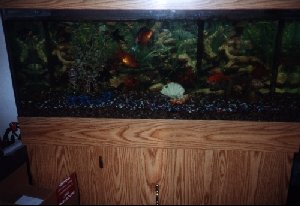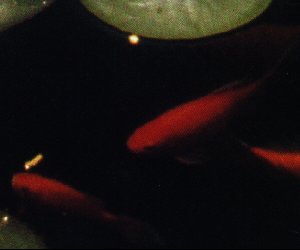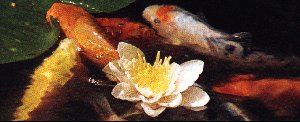| LinkExchange Member | Free Home Pages at GeoCities |
Whoopie! The Plants Are In...What Next?

Scavengers are nature's cleaning crew. They include snails and tadpoles. However, ours also ate baby fish and fish eggs layed along the wall and bottom of the pond. Our children really had fun watching the transition from tadpole into frog. We bought 5 and the kids soon learned to sneak up on the pond quietly or the tadpoles would dive for the bottom of the pond in fright!
There's a funny story also....soon after the frogs had gone through the transformation we had a hard time keeping track of them. They disappeared in the late afternoon and many times did not come back in the morning. A friend of ours stopped over one day and soon began complaining about all the noise in her backyard at night. Apparently, our bull frogs had found a new home. We wanted our daughter to sneak over and try to catch them, but how would we keep them in the pond once we got them back?? Betsy never did figure out how they inherited those wonderful bull frogs and we never told her. Eventually, they must have made their way to the lake, which was where they would end up anyway. In early fall, we take the frogs and toads that are visiting our pond down to the lake so they can do their winter thing.
Before you can add fish to your pond there are a few things you have to take care of first. Number one is getting rid of Chloramine. Chloramine is a chlorine and ammonia compound added to water treatment systems across the country. It is extremely dangerous to your fish, even more so than chlorine. Unlike chlorine, it will not naturally dissipate from the water. Chemicals must be used to neutralize it. Chloramine is insidious and slowly affects fish. General symptoms include hiding, not eating, listless behavior and ultimately death. You MUST add a product such as AquaSafe NH/CL or DeCHLOR everytime you add water to your pond (or fishtank). It's a good idea to keep enough on hand for an entire water change of your pond. When fish are stressed, ever-present pathogens may take control. Many factors cause stress: spawning, sudden temperature change, handling, oxygen depletion, high ammonia or nitrite levels etc. Rock salt is a good temporary treatment for restoring vigor. The slime layer and electrolytes are critical elements for healthy fish. One pound of rock salt treats 100 gallons of water as a one time treatment. If your fish seem to be gasping for breath, then it's time to add a pump and or fine-spray fountainhead to keep up the oxygen supply.
We purchased a self-circulating fountain (pictured on the main pond page). It has a small pump in the bottom section of the fountain which keeps the water bubbling out the top section. There's no other sound quite like it. We have a larger sump pump in the pond which is connected by plastic tubing to the fountain and a filter which then circulates and cleans the water. Additionally, we have a small fountainhead (changeable heads) that sprays a fine mist in different patterns. The whole effect is quite wonderful and makes gardening a pleasant chore.
The fish we bought for the pond the first summer are still with us. In the fall, we bring them into the house and they live in a 55 gallon aquarium which sets on a wooden cabinet (storage below is perfect for extra tubing, water treatment supplies etc.); the aquarium is pictured below.

Goldfish and koi are ideal ornamental pets. With little effort you can develop a friendship with your fish be feeding them floating food once or twice a day, as much as they can eat in 3 to 5 minutes. Feeding the fish was a special time for our children. Laying alongside the pond, the fish seemed to know when it was meal time and come to the surface, many times nibbling at the food from the kids' hand.
Don't worry if you're going on vacation for a week or two. Your fish will survive. Submerged plants and moss-like algae along the pondsides are good for them and will alleviate any guilt feelings you might have while you're away from home.
Again, remember, your pond shoud age for atleast 2 weeks before adding either fish or plants. This time frame gives nature time to achieve a biological balance. There are also products on the market to help with this process.
The residents of our pond are: 4 goldfish (now about 6 inches long), 4 calico goldfish (about 6 inches long) and 2 black mollies (about 5 inches long). Oh and 2 algae eaters with are the uglies fish you've ever seen! When we bought them last summer, they were about 1 1/2 inches long.....over the next 3 months they got slightly larger....6 inches long when we brought them inside. The owner at the pet store said that fish grow to their environment. Our fish might get as long as ten inches by the time they quit growing.
Below are pictures of both goldfish and koi fish. Koi fish vary in size and color, from 3 inches to 10 inches long. Japanese koi fish can be as long as 20 inches.

Goldfish

Koi Fish
Below, you will find a site index along with other homesteading links
| View Guestbook | |||
Last Updated July 10, 1998



